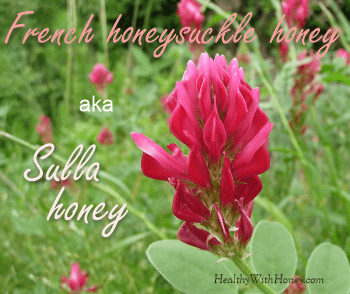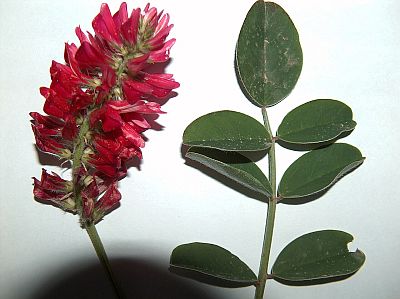How is French honeysuckle honey and where can we find it? Try Italy, Spain and Algeria.
The flower Hedysarum coronarium is known under many names: Sulla coronaria, French honeysuckle, Sweetvetch, Sweet Broom, cock’s head, Italian sainfoin, sulla, or soola.
The honey that is produced from it is usually named French honeysuckle honey or Sulla honey.
French honeysuckle is a bushy herbaceous perennial herb native to Malta, Algeria, Morocco, Tunisia, Italy and Spain. It is cultivated for animal fodder and hay in parts of Europe and northern Africa, because it is a highly palatable, nutritious and productive forage for ruminant production (de Koning et al., 2010; Foster, 2010) The species plays a key role in cereal-based systems of semi-arid regions, particularly in organic and low-input agriculture, and is commonly used to enhance the productivity and sustainability of farming systems (e.g. as a nitrogen supply and to maintain soil organic matter) (Ruisi et al., 2011).
It produces lots of nectar so it is also used for honey production.
French honeysuckle characteristics:
- The word hedysaron comes from the Greek words “hedys“ meaning “sweet” and “aron” meaning “from”; The word coronarium means pertaining to garlands;
- It has deep roots and grows up to 1–1.5 m tall;
- It likes full sun and not so much water. It is drought-resistant plant, the soil should be well-drained. It prefers gritty, moderately fertile, alkaline soils. Tolerates poor sandy or rocky soils;
- Its leaves are gray-green to medium green, odd-pinnate, compound, each with 7-15 elliptic to rounded leaflets;
- It blooms from June to July. Its flowers are extremely fragrant, bright red, pea-like flowers that bloom in late spring to early summer in dense axillary racemes atop upright flowering stems;
- Fruits are jointed and made of 2–4 spinulose articles. Pods have a yellow, thorny surface that turns brown at maturity.
- It is advised to cut back stems to the ground after frost. It is relatively easy to grow from seed.
- It attracts butterflies and honey bees alike.
- We can find it on borders, cottage gardens or cutting gardens.
How is French honeysuckle honey?
Different, according to geographical origin. This can greatly influences the qualitative and nutraceutical characteristics of honey. A study analyzed 24 French honeysuckle honeys from 8 different geographical areas from Southern Italy and the results showed that there really are big differences among its parameters, related to their production area. Especially the antioxidant activity, phenolic content and color of honey.
Smell: very tenuous and slightly floral, with notes of dried straw or grass;
Color: depends on the phenolic contents of honey.
It is thus a relative perspective. Its color can vary much from clear (the color of white wax or ice) to dark red (like of chestnut honey), as are French honeysuckle honey from Tarantino. ;
Taste: very sweet and refreshing. Very delicate.
Aroma: it has a delicate aroma of green legumes, straw and a trace of fresh walnuts. In some regions, it can have a floral aroma.
Phenolic content (mg GAE per kg honey): from 47.9 ± 25.6 (in Potentino) to 248.3 ± 31.1 (in Penisola Sorrentina);
Major phenolic acids: gallic, caffeic and ferulic acids.
The antioxidant activity:
· DPPH (I%): from 47.06 ± 8.60 (in Basso Pollino) to 88.25 ± 9.85 (in Penisola Sorrentina);
· FRAP [lM Fe(II)]: from 98.26 (in Potentino) ± 28.61 to 786.53 ± 91.28 (in Tarantino);
Water content: from 17.5 to 18.5%
HMF: 1.23 mg/kg (low)
Glucose: 32.2 ± 1.0
Fructose (g %): 34.8 ± 1.1
Electrical conductivity (mS): 126 ± 0.6
Diastase activity (Schade): 10.8 ± 0.2
Algerian French honeysuckle honey characteristics:
Humidity: 18.1 ± 2.4
pH: 3.6 ± 0.2
Free acidity: 39 ± 2.8
Color: light amber
Diastase: 14. ± 2.8
HMF: 7 ± 5.2 mg/100g
Polyphenols: 52.6 ± 7.8
Flavonoids: 3.8 ± 1.6
Na: 9.1 ± 5.1
K: 105.5 ± 71.4
P: 26.6 ± 4.8
Ca: 6.2 ± 3.2
Mg: 2.7 ± 1.7
Fe: 0.3 ± 0.1
Other traces of Mn, Cu, Zn.
French honeysuckle honey has a high content of diastase.
The presence of diastase, aka amylase, in honey has been attributed to the salivary secretions of bees, which doesn’t help us in understanding why honeys of diverse botanical origin show a different diastatic activity. Scientists have proposed different explanations, but I’ll skip them for now.
A study done in 1988 showed the differences in diastase content between different honeys. Robinia, Citrus, Erica, Taraxacum and Arbutus honeys were found to have a very low enzyme content, while Hedysarum (our French honeysuckle), Castanea, Honeydew, Eucalyptus and Thymus honeys showed high diastase activity.
The French honeysuckle honey had a mean index of 19.8±6, while acacia honey for example has only 8.4±2.9. The highest value was 33.1±4.7 and belonged to thyme honey.
What is diastase exactly and why are we interested in it?
Diastase is an enzyme. Enzymes are complex protein molecules found in every cell of any living organisms: humans, honey bees and everything else, plant or animal. Molecules that accelerate, or catalyze, chemical reactions in our body.
Diastase, aka amylase, transforms starch to other carbohydrates (dextrins, oligodi- and monozaccharides). So, yes, the content of diastase in honey is important.
read more on What are the enzymes present in raw honey? Why are they important?
Often times we find it combined with citrus, clover, black locust and vetch.
Folk medicine says French honeysuckle honey has an antiseptic and stimulating action for our immune system and bones, with important diuretic and purifying properties.
Picture source:
Giancarlo Dessi via wikimedia commons
Lucarelly via wikimedia commons
References and further reading:
Antioxidant properties and phenolic content of sulla (Hedysarum spp.) honeys from Southern Italy;
Effects of conditioning on HMF content in unifloral honeys



French honeysuckle honey is a true gem of nature, offering a delightful blend of sweetness and delicate floral notes. Its high diastase content and rich polyphenol profile make it not only delicious but also nutritious. Whether drizzled over toast or added to a cup of tea, this honey adds a touch of elegance to any culinary creation. A must-try for honey enthusiasts seeking a unique and flavorful experience!
Hello Alexandru,
You talk like a true connoisseur! 🙂 I’m glad you like it.
Thanks for stopping by.
Laura